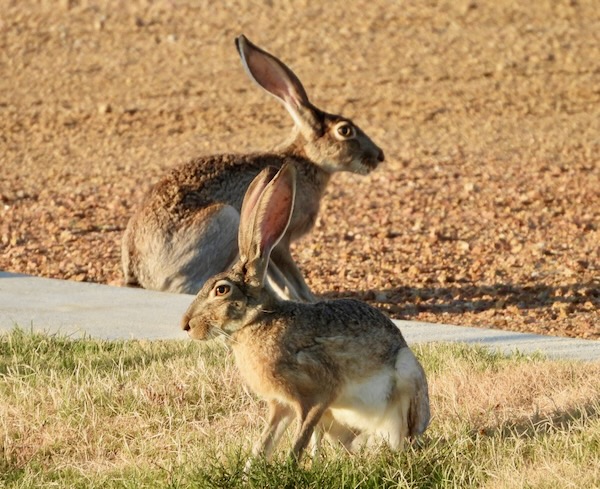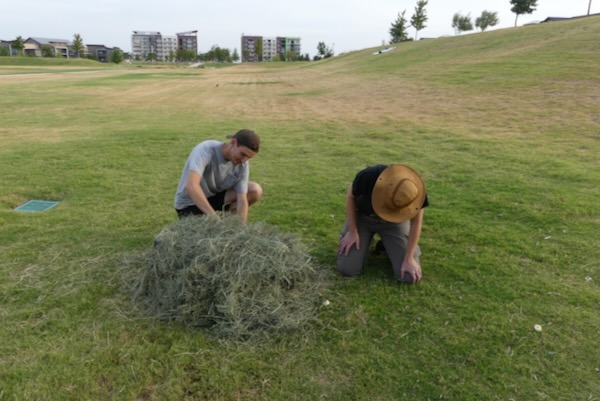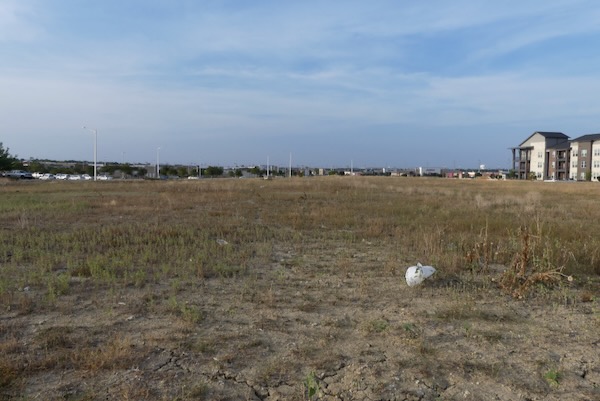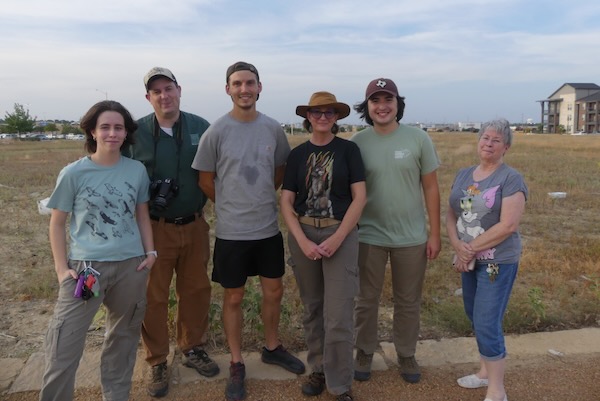
A black-tailed jackrabbit is spotted at the edge of Rayzor Ranch Park in Denton. Photo by Jaime Baxter-Slye.
Sept. 8, 2023
Black-tailed jackrabbits are a familiar sight on Texas ranchland
But in Denton, a group of wild hares have watched their rural home shrink as the city grew around it. Today, the jackrabbits are living on an island of habitat, slated for development.
Now a University of North Texas instructor, her students and a wildlife rehabilitator are doing what they can to save six to 10 black-tailed jackrabbits (the exact number is uncertain) with the city’s blessing.
The animals are the last of a population that lived on the Rayzor Ranch, where longhorn cattle once grazed on the prairie.
“The land was sold in the early 2000s to a development project that really didn’t kick off until the last four years,” said Brand Richter, a University of North Texas student.
Richter expects that within a year to 18 months, the remaining scrubby lots will be developed. That would leave the jackrabbits dependent on 9.86-acre Rayzor Ranch Park.
 Two jackrabbits at the edge of the Rayzor Ranch Park. Photo by Jaime Baxter-Slye.
Two jackrabbits at the edge of the Rayzor Ranch Park. Photo by Jaime Baxter-Slye.
“Through our collaborations and partnerships, we want to find the best way to get these guys in a space that’s going to work out better for them,” he said.
Initially, the city of Denton hoped that the park could provide them a home.
But Jaime Baxter-Slye, UNT Instructional Laboratory Supervisor for the Department of Biological Sciences, was skeptical when she heard of the plan.
“This park, with its manicured lawns, doesn’t have the needed habitat so they would eventually not do well.”
Richter noted that the area has lots of red-tailed hawks, which prey upon small animals like the jackrabbits, and there would be no good place to hide.
RABBIT OR HARE?
Jackrabbits are not the same as the smaller and familiar cottontail rabbits. They are in the same family (Leporidae), but jackrabbits are called “hares” rather than rabbits – a bit confusing for an animal called a “jackrabbit.”
The black-tailed jackrabbit has long ears tipped in black and long legs. It is at home in open grasslands and desert scrub where it eats grasses, herbs, crops like alfalfa, cactus and mesquite. According to David Schmidly’s book, The Mammals of Texas (Revised Ed.), they prefer sparse vegetation, even overgrazed pastureland. Jackrabbits generally spend the hotter part of the day in a small area (called a “form”) scratched out at the base of a shrub or clump of grass that can provide a bit of shade and makes it harder for a predator to see them.
THE NIGHT SHIFT
 The author and Texas Parks and Wildlife biologist Sam Kieschnick in front, with the relocation team, behind watching for jackrabbit activity. Photo by Jaime Baxter-Slye.
The author and Texas Parks and Wildlife biologist Sam Kieschnick in front, with the relocation team, behind watching for jackrabbit activity. Photo by Jaime Baxter-Slye.
Black-tailed jackrabbits become active at sunset and forage deep into the night. I joined the jackrabbit relocation team at sunset on Aug. 22 to learn about their efforts and hopefully see the first jackrabbit trapped and relocated.
There are many kinds of traps, and some of them injure animals. The traps used by the relocation team are designed to avoid injuring the hares.
“These are live traps that have a pressure plate down at the center so that it’s touch activated,” Richter explained.
When an animal steps on the plate, a gate closes behind them so that they cannot get out.
“We are here, monitoring the entire time, making sure that when we do have an animal secure in the trap we can get to it quickly,” he said.
A jackrabbit caught in this way would be moved to the relocation site that same evening.
Diana Leggett, a wildlife rehabilitator and president of WildRescue Inc., who specializes in wild rabbit rehab, is as part of the jackrabbit team.
“The jackrabbits are very sensitive to touch and texture,” she said.
The traps are heavily lined with hay so the hares don’t touch metal. That makes it more likely they would enter the trap.
STAKE OUT
 Brand Richter and Jaime Baxter-Slye preparing a trap. Photo by Michael Smith.
Brand Richter and Jaime Baxter-Slye preparing a trap. Photo by Michael Smith.
From a grassy knoll in the park, we watched the field to the north as the hares began to be active. They gravitate toward the park as it gets dark, partly drawn by the sprinkler system that will provide a much-needed drink when they activate. Traps were set within the park where the team has permission to do so.
“I see two. Oh, now there’s three over near that sign,” someone said while looking through binoculars.
I saw a couple of them moving around, but the fading light and limits of my zoom lens didn’t get much of a photo.
“Capture is a last resort,” Leggett said.
Partly because the stress of capture can lead to a usually fatal condition called capture myopathy.
The condition can damage muscles and organs due to stress and extreme exertion as an animal tries to outrun a predator or escape from restraint.
“Vitamin E and selenium is what we use to help counteract capture myopathy,” said Leggett, saying that it would be added to food while being transported to the release site. (Please consult with a veterinary professional before using).
WEIGHING THE RISKS
 Some of the jackrabbits spend their days in this field that is scheduled for development. Photo by Michael Smith.
Some of the jackrabbits spend their days in this field that is scheduled for development. Photo by Michael Smith.
The relocation team has weighed the risks and benefits of moving these jackrabbits.
The team decided that relocation has a chance to provide a better outcome.
“This is a species that doesn’t do well in urban areas so it needs those wide swaths of land,” Sam Kieschnick, a Texas Parks & Wildlife Urban Biologist, on hand to provide expertise. “With urbanization, they go somewhere else or simply die.”
Leggett agreed.
“They are excellent adapters, but there is only so much they can adapt to,” she said. “We have lost our wildlife corridors. And we are in the process of trying to re-open that door and establish some corridors.”

Sunset at Rayzor Ranch Park, which offers a barren and unsafe alternative for the jackrabbits. Photo by Michael Smith.
But in this case, there is no good corridor or escape route that would allow these animals to move on their own.
Baxter-Slye talked about the city’s efforts to come up with a solution. Since the Rayzor Ranch Park wouldn’t do, the city suggested relocating them to Clear Creek Natural Heritage Center. “That area is big and has a diverse set of habitat types,” Baxter-Slye said. “But the prairie grassland that they do have is more of the tallgrass dense grasses, and what they like is this shorter, scrubbier type of area.”
She added that Clear Creek has many natural predators. A larger group of jackrabbits could survive that, “but a small group would be easy pickings.”
Meanwhile, we continued to sit in the park and watch the hares move toward us under cover of night. One of them crossed a gravel road and approached a trap where the team had placed a few chunks of apple and banana. All of us watched breathlessly as the jackrabbit loped in front of the trap and turned toward it. The hare approached – paused – and appeared to pick up a bite of fruit, casually moving away to enjoy it.
That was the closest the team got to trapping a jackrabbit that evening. However, they become less wary of the traps each time the team is there, and success may be on the horizon.
A BEAUTIFUL NEW HOME
 The jackrabbit rescue team: from left, Abby Heath, Sam Kieschnick, Brand Richter, Jaime Baxter-Slye, Jonothon Cantu, and Diana Leggett. Photo by Michael Smith.
The jackrabbit rescue team: from left, Abby Heath, Sam Kieschnick, Brand Richter, Jaime Baxter-Slye, Jonothon Cantu, and Diana Leggett. Photo by Michael Smith.
We talked about where the jackrabbits would be relocated. It is a nearby ranch west of I-35 with 1,000 acres of pasture with landscape features that allow them to shelter as well as find food. There is an existing population of hundreds of jackrabbits. With plenty of room and resources, adding a small group of hares should not trigger any territoriality among the animals.
Baxter-Slye spoke of an additional benefit of moving these jackrabbits. The Rayzor Ranch population has been isolated for some time. Baxter-Slye explained that when small populations are isolated for some time, the genetic health of the animals can suffer.
“If you have mutations that arise in the population, it can be detrimental.”
If there is a mutation that causes disease or poorer adaptation, in a small group it could be spread more widely. Moving them to the west of I-35 would increase the genetic diversity of that population.
This is a story in which we can imagine a wonderful outcome, but the story is still in progress. So far, we know that the jackrabbits are facing a dire ending unless they are rescued. With luck, the relocation team will get that little group of hares to a better home.
RELATED ARTICLES
Coyotes rattle some North Texans, but experts say we can coexist
Wildlife relocation is discouraged by animal experts
Dallas rehabber says wild rabbit rescues multiply in spring
DFW bunny lovers double down to help abandoned pet rabbits
Rookery thrives within Dallas medical district
Stay up to date on everything green in North Texas, including the latest news and events! Sign up for the weekly Green Source DFW Newsletter! Follow us on Facebook,Twitter and Instagram. Also check out our podcast The Texas Green Report, available on your favorite podcast app.









